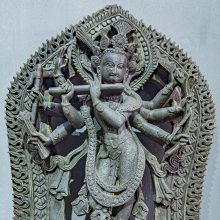Ratnakundala, Ratnakuṇḍala, Ratna-kundala: 3 definitions
Introduction:
Ratnakundala means something in Hinduism, Sanskrit. If you want to know the exact meaning, history, etymology or English translation of this term then check out the descriptions on this page. Add your comment or reference to a book if you want to contribute to this summary article.
Images (photo gallery)
In Hinduism
Shilpashastra (iconography)
Source: Wisdom Library: Śilpa-śāstraRatnakuṇḍala (रत्नकुण्डल):—One of the five kinds of commonly known ear-ornaments (kuṇḍala). This ornament is a jewelled circular ear-ring.
Source: Shodhganga: Vaisnava Agamas And Visnu ImagesRatnakuṇḍala (रत्नकुण्डल) refers to one of the various types of “ear-ornaments” (karṇabhūṣaṇa or kuṇḍala), as defined in treatises such as the Pāñcarātra, Pādmasaṃhitā and Vaikhānasa-āgamas, extensively dealing with the technical features of temple art, iconography and architecture in Vaishnavism.

Shilpashastra (शिल्पशास्त्र, śilpaśāstra) represents the ancient Indian science (shastra) of creative arts (shilpa) such as sculpture, iconography and painting. Closely related to Vastushastra (architecture), they often share the same literature.
Purana and Itihasa (epic history)
Source: archive.org: Shiva Purana - English TranslationRatnakuṇḍala (रत्नकुण्डल) refers to “diamond earrings”, according to the Śivapurāṇa 2.3.46 (“The arrival of the bridegroom”).—Accordingly, as Brahmā narrated to Nārada: “[...] In the meantime the servant-maids in the harem of the mountain took Pārvatī out in order to worship the tutelar family deity. [...] With diamond earrings (ratnakuṇḍala) her cheeks appeared brilliant. Her rows of teeth sparkled like diamonds. Red lac applied over her lips which were naturally red like Bimba fruits was exquisite. [...]”.

The Purana (पुराण, purāṇas) refers to Sanskrit literature preserving ancient India’s vast cultural history, including historical legends, religious ceremonies, various arts and sciences. The eighteen mahapuranas total over 400,000 shlokas (metrical couplets) and date to at least several centuries BCE.
See also (Relevant definitions)
Partial matches: Ratna, Kundala.
Full-text: Kundala.
Relevant text
Search found 7 books and stories containing Ratnakundala, Ratna-kundala, Ratna-kuṇḍala, Ratnakuṇḍala; (plurals include: Ratnakundalas, kundalas, kuṇḍalas, Ratnakuṇḍalas). You can also click to the full overview containing English textual excerpts. Below are direct links for the most relevant articles:
Garga Samhita (English) (by Danavir Goswami)
Verses 5.7.16-17 < [Chapter 7 - The Killing of Kuvalayāpīḍa]
Verses 6.19.6-10 < [Chapter 19 - In the First Fortress of Dvārakā, the Glories of Līlā-sarovara, etc.]
Cosmetics, Costumes and Ornaments in Ancient India (by Remadevi. O.)
2.2. Ear Ornaments (a): Kuṇḍala < [Chapter 3 - Ornaments]
Sripura (Archaeological Survey) (by Bikash Chandra Pradhan)
The Metal Art < [Chapter 3 - Sculptural Programme]
The Religion and Philosophy of Tevaram (Thevaram) (by M. A. Dorai Rangaswamy)
Chapter 4.6 - (l) Shiva’s ornamentation < [Volume 2 - Nampi Arurar and Mythology]
Chapter 1.3 - Umabhaga-murti (depiction of the Mother Goddess) < [Volume 2 - Nampi Arurar and Mythology]
Jain Remains of Ancient Bengal (by Shubha Majumder)
Śāsanadevīs or Yakṣiṇīs from Ancient Bengal < [Chapter 6 - Iconographic Study of Jaina Sculptural Remains]
Miniature Tīrthaṅkara and Planatary Deities type of Śāntinātha < [Chapter 6 - Iconographic Study of Jaina Sculptural Remains]
Pallava period (Social and Cultural History) (by S. Krishnamurthy)
Ear Ornaments (Karnabhushana) < [Chapter 4 - Material Culture of the People]
